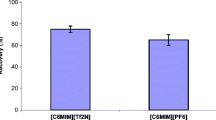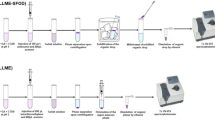Abstract
A solid-phase extraction (SPE) coupled with dispersive liquid–liquid microextraction based on the solidification of floating organic drop (DLLME-SFO) method has been developed for extraction and determination of organic bisphenol A (BPA) in different real samples. Bisphenol A was determined by high-performance liquid chromatography-fluorescence detector (HPLC-FL). Variables affecting the performance of both steps were thoroughly investigated. The analytical characteristics of the method were determined. The calibration graph is linear in the range of 0.005–10 ng g−1 with detection limit of 0.002 ng g−1. The relative standard deviation (RSD) for of BPA in different samples are in the range of 6.8–9.6 % (n = 5). The obtained results show that SPE-DLLME-SFO combined with HPLC-FL is a fast and simple method for the determination of BPA in food and environmental samples.








Similar content being viewed by others
References
Basheer C, Lee HK (2004) Analysis of endocrine disrupting alkylphenols, chlorophenols and bisphenol A using hollow fiber-protected liquid-phase microextraction coupled with injection port-derivatization gas chromatography–mass spectrometry. J Chromatogr A 1057:163–169
Biedermann-Brem S, Grob K, Fjeldal P (2008) Release of bisphenol A from polycarbonate baby bottles: mechanisms of formation and investigation of worst case scenarios. Eur Food Res Technol 227:1053–1060
Braunrath R, Podlipna D, Padlesak S, Cichna-Markl M (2005) Determination of bisphenol A in canned foods by immunoaffinity chromatography, HPLC, and fluorescence detection. J Agric Food Chem 53:8911–8917
Chen B, Huang Y, He M, Hu B (2013) Hollow fiber liquid-liquid-liquid microextraction combined with high performance liquid chromatography-ultraviolet detection for the determination of various environmental estrogens in environmental and biological samples. J Chromatogr A 1305:17–26
Cunha SC, Almeida C, Mendes E, Fernandes JO (2011) Simultaneous determination of bisphenol A and bisphenol B in beverages and powdered infant formula by dispersive liquid–liquid microextraction and heart-cutting multi dimensional gas chromatography-mass spectrometry. Food Addit Contam 28:513–526
Cunha SC, Cunha C, Ferreira AR, Fernandes JO (2012) Determination of bisphenol A and bisphenol B in canned seafood combining QuEChERS extraction with dispersive liquid–liquid microextraction followed by gas chromatography–mass spectrometry. Anal Bioanal Chem 404:2453–2463
Cunha SC, Fernandes JO (2013) Assessment of bisphenol A and bisphenol B in canned vegetables and fruits by gas chromatography-mass spectrometry after QuEChERS and dispersive liquid-liquid microextraction. Food Control 33:549–555
Cunha SC, Fernandes JO (2010) Quantification of free and total bisphenol A and bisphenol B in human urine by dispersive liquid–liquid microextraction (DLLME) and heart-cutting multi dimensional gas chromatography–mass spectrometry (MD–GC/MS). Talanta 83:117–125
Daneshfar A, Lotfi HJ, Khezeli T (2011) Determination of nalidixic acid using dispersive liquid-liquid microextraction followed by HPLC-UV. Acta Chromatogr 23:567–577
EFSA. 2013. German Federal Environment Agency 2010. <http://www.efsa.europa.eu/en/topics/topic/bisphenol.htm?wtrl=01>. Accessed at January of 2013.
Farajzadeh MA, Dj D, Bakhtiyari RF (2010) Use of a capillary tube for collecting an extraction solvent lighter than water after dispersive liquid-liquid microextraction and its application in the determination of parabens in different samples by gas chromatography-flame ionization detection. Talanta 81:1360–1367
Farajzadeh MR, Seyedi SE, Safi Shalamzari M, Bamorowat M (2009) Dispersive liquid-liquid microextraction using extraction solvent lighter than water. J Sep Sci 32:3191–3200
Fiamegos YC, Stalikas CD (2007) In-drop derivatisation liquid-phase microextraction assisted by ion-pairing transfer for the gas chromatographic determination of phenolic endocrine disruptors. Anal Chim Acta 597:32–40
Geens T, Apelbaum TZ, Goeyens L, Neels H, Covaci A (2010) Intake of bisphenol A from canned beverages and foods on the Belgian market. Food Addit Contam A 27:1627–1637
Grumetto L, Montesano D, Seccia S, Alberizio S, Barbato F (2008) Determination of bisphenol a and bisphenol B residues in canned peeled tomatoes by reversed-phase liquid chromatography. J Agric Food Chem 56:10633–7
Gu Y, Yu X, Peng J, Chen S, Zhong Y, Yin D, Hu X (2014) Simultaneous solid phase extraction coupled with liquid chromatography tandem mass spectrometry and gas chromatography tandem mass spectrometry for the highly sensitive determination of endocrine disrupting chemicals in seafood. J Chromatogr B 965:164–172
Inouea K, Murayama S, Takebab K, Yoshimura Y, Nakazawa H (2003) Contamination of xenoestrogens bisphenol A and F in honey: safety assessment and analytical method of these compounds in honey. J Food Compos Anal 16:497–506
Kavlock RJ (1999) Overview of endocrine disruptor research activity in the United States. Chemosphere 39:1227–1236
Kawaguchi M, Hayatsu Y, Nakata H, Ishii Y, Ito R, Saito K, Nakazawa H (2005) Molecularly imprinted solid phase extraction using stable isotope labeled compounds as template and liquid chromatography–mass spectrometry for trace analysis of bisphenolA in water sample. Anal Chim Acta 539:83–89
Kawaguchi M, Inoue K, Yoshimura M, Ito R, Sakui N, Okanouchi N, Nakazawa H (2004) Determination of bisphenol A in river water and body fluid samples by stir bar sorptive extraction with in situ derivatization and thermal desorption-gas chromatography–mass spectrometry. J Chromatogr B 805:41–48
Kawaguchi M, Ito R, Okanouchi N, Saito K, Nakazawa H (2008) Miniaturized hollow fiber assisted liquid phase microextraction with in situ derivatization for analysis of bisphenolA in human urine sample by gas chromatography–mass spectrometry. J Chromatogr B 870:98–102
Lázaro Martínez JM, Denis MFL, Denaday LR, Dall’Orto VC (2009) Development and characterization of a new polyampholyte-surfactant complex applied to the solid phase extraction of bisphenol A. Talanta 80:789–796
Leong MI, Huang SD (2008) Dispersive liquid- liquid microextraction method based on solidification of floating organic drop combined with gas chromatography with electron-capture or mass spectrometry detection. J Chromatogr A 1211:8–12
Li JH, Lu WH, Ma JP, Chen LX (2011) Determination of mercury (II) in water samples using dispersive liquid-liquid microextraction and back extraction along with capillary zone electrophoresis. Microchim Acta 175:301–308
Li J, Song X (2013) Dispersive liquid-liquid microextraction coupled with in situ derivatization for determination of bisphenol A in water samples by gas chromatography–mass spectrometry. Sci J Environ Pollut Protect 2:50–58
Liu S, Xie Q, Chen J, Sun J, He H, Zhang X (2013) Development and comparison of two dispersive liquid–liquid microextraction techniques coupled to high performance liquid chromatography for the rapid analysis of bisphenol A in edible oils. J Chromatogr A 1295:16–23
Liu X, Ji Y, Zhang H, Liu M (2008a) Elimination of matrix effects in the determination of bisphenol A in milk by solid-phase micro extraction-high-performance liquid chromatography. Food Addit Contam A 25:772–778
Liu XY, Zhang XY, Zhang HX, Liu MC (2008b) A chemometric strategy for optimization of solid-phase microextraction: determination of bisphenol A and 4-nonylphenol with HPLC. J Chromatogr Sci 46:590–600
Ma JP, Lu WH, Chen LX (2012) Recent advances in dispersive liquid–liquid microextraction for organic compounds analysis in environmental water: a review. Curr Anal Chem 8:78–90
Maragou NC, Lampi EN, Thomaidis NS, Koupparis MA (2006) Determination of bisphenol A in milk by solid phase extraction and liquid chromatography-mass spectrometry. J Chromatogr A 1129:165–173
Mudiam MKR, Jain R, Dua VK, Singh AK, Sharma VP, Murthy RC (2011) Application of ethyl chloroformate derivatization for solid-phase microextraction-gas chromatography-mass spectrometric determination of bisphenol A in water and milk samples. Anal Bioanal Chem 401:1695–1701
Oldring PK, Nehring U (2007) Metal packaging materials 7. Metal packaging for foodstuffs. Institute for Life Sciences International, Brussels
Pirsaheb M, Fattahi N, Shamsipur M (2013) Determination of organophosphorous pesticides in summer crops using ultrasound-assisted solvent extraction followed by dispersive liquid- liquid microextraction based on the solidification of floating organic drop. Food Control 34:378–385
Raouf Yazdinezhad S, Ballesteros-Gómez A, Lunar L, Rubio S (2013) Single-step extraction and cleanup of bisphenol A in soft drinks by hemimicellar magnetic solid phase extraction prior to liquid chromatography/tandem mass spectrometry. Anal Chim Acta 778:31–37
Rezaee M, Yamini Y, Shariati S, Esrafili A, Shamsipur M (2009) Dispersive liquid–liquid microextraction combined with high-performance liquid chromatography-UV detection as a very simple, rapid and sensitive method for the determination of bisphenol A in water samples. J Chromatogr A 1216:1511–1514
San Vicente B, Navarro Villoslada F, Moreno-Bondi MC (2004) Continuous solid-phase extraction and preconcentration of bisphenol A in aqueous samples using molecularly imprinted columns. Anal Bioanal Chem 380:115–220
Song XL, Li JH, Liao CY, Chen LX (2011) Ultrasound-assisted dispersive liquid–liquid microextraction combined with low solvent consumption for determination of polycyclic aromatic hydrocarbons in seawater by GC–MS. Chromatographia 74:89–98
Szymański A, Rykowska I, Wasiak W (2006) Determination of bisphenol a in water and milk by micellar liquid chromatography. Acta Chromatogr 17:161–172
Thomson BM, Grounds PR (2005) Bisphenol A in canned foods in New Zealand: an exposure assessment. Food Addit Contam 22:65–72
Vilchez JL, Zafra A, Gonzalez-Casado A, Hotoria E, Olmo M (2001) Determination of trace amounts of bisphenol F, bisphenol A and their diglycidyl ethers in wastewater by gas chromatography–mass spectrometry. Anal Chim Acta 431:31–40
Viñas P, Campillo N, Martínez-Castillo N, Hernández-Córdoba M (2010) Comparison of two derivatization-based methods for solid phase microextraction-gas chromatography–mass spectrometric determination of bisphenolA, bisphenol S and biphenol migrated from food cans. Anal Bioanal Chem 397:115–125
Vom Saal FS, Hughes C (2005) An extensive new literature concerning low-dose effects of bisphenol A shows the need for a new risk assessment. Environ Health Perspect 113:926–33
Wang X, Diao CP, Zhao RS (2009) Rapid determination of bisphenol A in drinking water using dispersive liquid-phase microextraction with in situ derivatization prior to GC-MS. J Sep Sci 32:154–159
Wei X, Huang Y, Wong MH, Giesy JP, Wong CKC (2011) Assessment of risk to humans of bisphenol A in marine and freshwater fish from Pearl River Delta, China. Chemosphere 85:122–128
Wen YY, Li JH, Ma JP, Chen LX (2012) Recent advances in enrichment techniques for trace analysis in capillary electrophoresis. Electrophoresis 33:2933–2952
Yoshida T, Horie M, Hoshino Y, Nakazawa H, Horie M, Nakazawa H (2001) Determination of bisphenol A in canned vegetables and fruit by high performance liquid chromatography. Food Addit Contam 18:69–75
Zhou Q, Gao Y, Xie G (2011) Determination of bisphenol A, 4-n-nonylphenol, and 4-tert-octylphenol bytemperature-controlled ionic liquid dispersive liquid-phase microextraction combined with high performance liquid chromatography-fluorescence detector. Talanta 85:1598–1602
Acknowledgments
The authors thank the research council of Razi University of Kermanshah (Iran) for the financial support.
Compliance with Ethics Requirements
ᅟ
Conflict of Interest
Marzieh Sadeghi has received research grants from the Department of Chemistry, Razi University, Kermanshah, Iran. Ziba Nematifar declares that he has no conflict of interest. Nazir Fattahi declares that he has no conflict of interest. Meghdad Pirsaheb declares that he has no conflict of interest. Mojtaba Shamsipur declares that he has no conflict of interest.
Ethical Approval
This article does not contain any studies with human or animal subjects.
Informed Consent
Not applicable.
Author information
Authors and Affiliations
Corresponding author
Rights and permissions
About this article
Cite this article
Sadeghi, M., Nematifar, Z., Fattahi, N. et al. Determination of Bisphenol A in Food and Environmental Samples Using Combined Solid-Phase Extraction–Dispersive Liquid–Liquid Microextraction with Solidification of Floating Organic Drop Followed by HPLC. Food Anal. Methods 9, 1814–1824 (2016). https://doi.org/10.1007/s12161-015-0357-6
Received:
Accepted:
Published:
Issue Date:
DOI: https://doi.org/10.1007/s12161-015-0357-6




